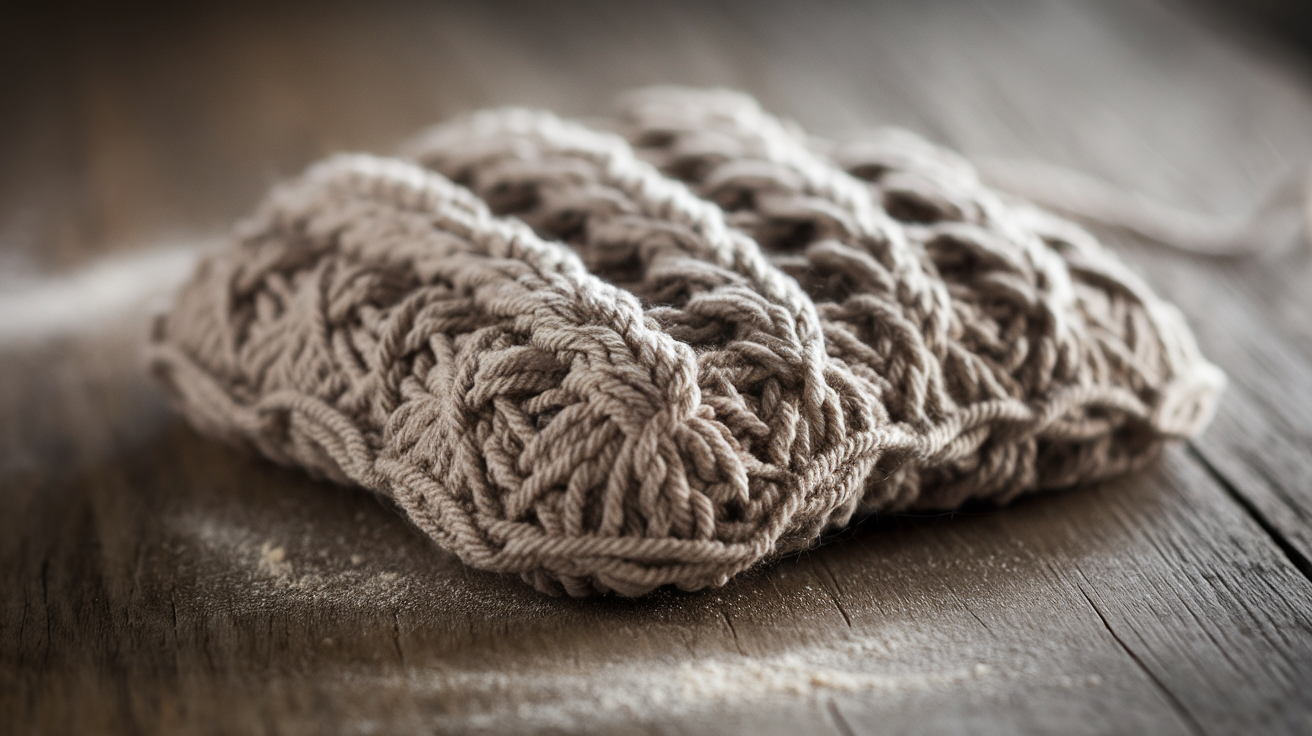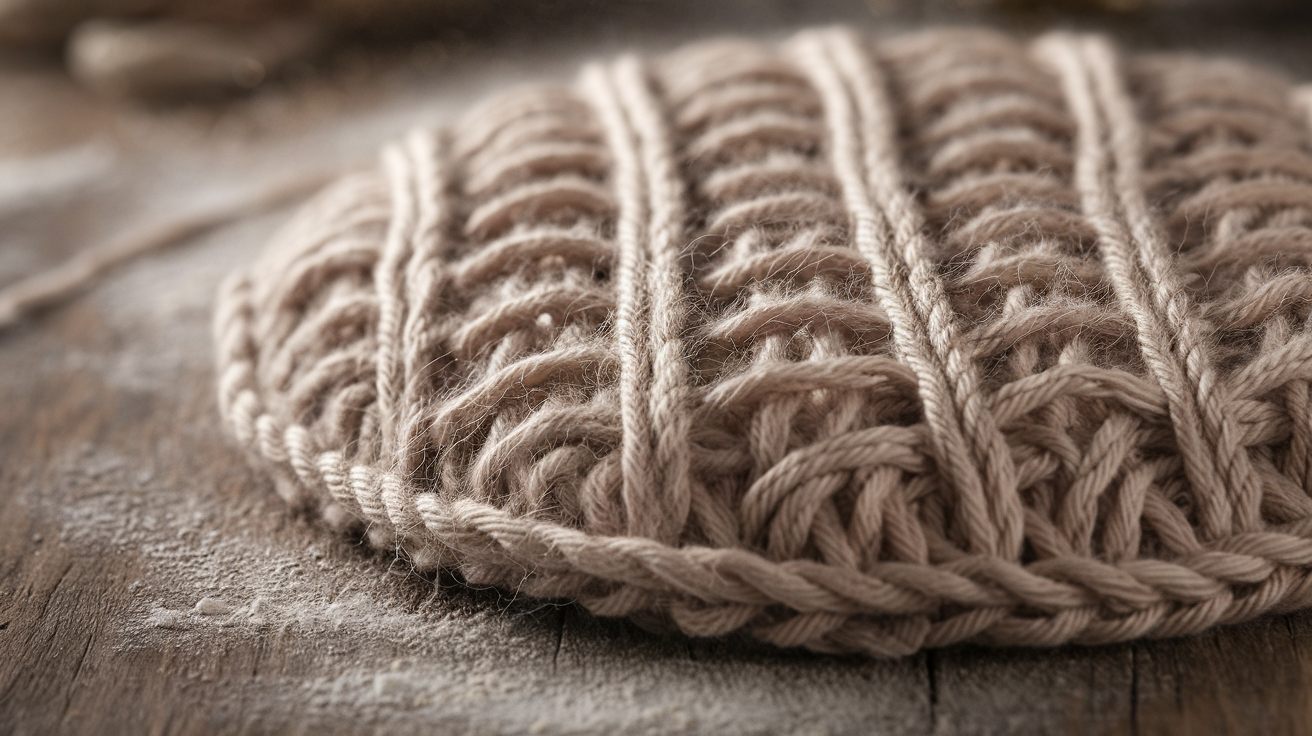How To Knit A Linen Stitch Hot Pad

Creating a linen stitch hot pad results in a double thick, beautiful woven effect, offering both satisfying craftsmanship and practical function for protecting your hands and kitchen surfaces. Every few rows of this potholder pattern, a distinctly textured fabric emerges as you alternate knit and slip stitch techniques, transforming sturdy cotton yarn into a dense square with remarkable visual depth.
This project is exceptionally beginner friendly, sidestepping advanced techniques while providing ample opportunity to customize size or color.
Mastering the unique woven effect of linen stitch knitting allows you to create a long-lasting, unique kitchen accessory that withstands daily use and showcases your creative flair.
Gathering Your Knitting Supplies
Before embarking on the linen stitch knitting journey, assembling the correct supplies is essential for effective crafting.
Start by selecting approximately 150 yards of worsted weight cotton yarn; its natural fibers guarantee superior heat protection and durability for your durable kitchen accessory. You will require a pair of US size 9 (5 mm knitting needles) to achieve a firm fabric with a pleasingly dense texture.
Procure a yarn needle and scissors, indispensable tools for tidily sewing edges and weaving in loose yarn ends. For added insulation and a finish with minimal sewing, consider a cotton liner, perhaps cut from a repurposed towel or similar material.
These carefully chosen tools empower you to craft a truly useful accessory aligned with your kitchen’s specific requirements.
Necessary Materials for Your Project
Cotton yarn in a worsted weight selection serves as an excellent foundation for this project, offering both durability and excellent heat resistance, making it ideal for a potholder pattern.
You’ll need around 150 yards of this material.
Ensure you have a pair of US size 9 (5 mm knitting needles), which are perfect for achieving the characteristic firm fabric and dense texture of the linen stitch. A yarn needle is vital for weaving in ends neatly, and scissors are necessary for cutting the yarn.
For enhanced heat protection and a truly double thick finished product, an optional cotton liner provides an extra layer of insulation, contributing to a more robust and protective kitchen item.
Preparing Your Workspace and Tools
Gauge swatch creation is an important first step to ensure your finished hot pad achieves the desired dimensions, aiming for a fabric that is both firm and dense. The recommended finished size for this kitchen accessory is approximately a 10 inch square.
Proper preparation prevents frustration down the line, making the overall crafting experience more enjoyable and leading to a superior end product.
These preparatory steps help guarantee a successful outcome for your creative crafting endeavor.
The Initial Cast On
Casting on your stitches is the foundational step for creating your two thick creation.
Whether you choose to knit in the round for a truly seamless construction or opt for flat knitting to be sewn closed later, the initial cast on sets the stage. A crochet caston can provide a bit more stretch, or a standard cast on works just as well.
For knitting in the round, you’ll cast on approximately 100 stitches to create a seamless tube that can be folded to form the double thickness. If working flat, cast on the desired width, keeping in mind that you will later fold and sew the edges to achieve the same result, ensuring a neat finish for your handmade item.
Executing the Linen Stitch Pattern
The distinctive look of the linen stitch knitting is achieved through a simple yet elegant sequence of knit and slip stitches, creating a beautiful faux-linen or woven look.
On the right side, the pattern involves knitting one stitch, then slipping the next with the yarn held in front (wyif), repeating this sequence across the row.
For the subsequent row, you’ll purl one stitch, then slip the next with the yarn held in back (wyib), again repeating this across the row.
Consistently carrying the working yarn snugly across the front or back when slipping stitches is key to maintaining the fabric’s integrity and that desirable textured fabric appearance. This methodical approach ensures snuggled stitches and a visually appealing result.
Knitting Your Hot Pad to Completion
Continue working rows following the established linen stitch pattern until your piece reaches the desired dimensions for a perfect square, approximately a 10 inch square.
If you are knitting in the round, a yarn marker becomes invaluable for keeping track of your progress and ensuring you maintain an even fabric. For those knitting flat knitting, simply continue until the length matches the width of your cast-on edge.
This stage also presents a wonderful opportunity for incorporating stripes or using up those delightful scrap yarn colors, adding a personal touch to your kitchen decor.
The continuous knitting in this stitch creates a wonderfully dense fabric ideal for its purpose.
Finishing Touches for Your Kitchen Accessory
The finishing the pad stage involves several options depending on your chosen construction method, ensuring a polished look for your creation.
If you’ve decided on incorporating a cotton liner for enhanced heat resistance and table protection, now is the time to insert it securely before closing the piece. For those who knitted in the round, you can either use the ingenious kitchener stitch for grafting stitches and a nearly invisible seam, or you can simply bind off and use your yarn needle to meticulously sew edges closed.
If you worked your project knitting flat, fold the piece and use a similar method to sew edges, ensuring no gaps remain. Finally, weaving

Mastering the Linen Stitch Technique
Linen stitch knitting creates a delightfully dense, woven-like surface by alternating simple knit and slip stitches, bestowing this hot pad with exceptional texture and impressive durability. This potholder pattern is key to the hot pad’s durability.
By following each row meticulously—working a “knit one, slip stitch with yarn in front” sequence, then alternating with a “purl one, slip stitch with yarn in back” on the subsequent row—you effectively shape a firm fabric that remains resilient against even the highest kitchen temperatures.
Keeping the working yarn snug and secure when slipping stitches is absolutely essential for achieving the beautiful woven effect and ensuring seamless construction.
Consistent tension throughout your knitting process leads to a cohesive, double thick hot pad that is perfectly ideal for superior heat protection and provides long-lasting, dependable use. Transitioning next, a foundational understanding of the slip stitch technique is paramount for truly mastering this uniquely textured fabric’s distinctive, attractive pattern.
Learn to create a dense, woven-like fabric by alternating knit and slip stitches across rows.
This pattern is key to the hot pads texture and durability.
Linen stitch knitting forms a dense, woven-like surface by alternating simple knit and slip stitches, giving this hot pad exceptional texture and durability. By following each row—working a “knit one, slip stitch with yarn in front” sequence, then alternating with a “purl one, slip stitch with yarn in back” on the next—you shape a firm fabric that’s resilient against high kitchen temperatures.
Keeping the working yarn snuggled when slipping stitches is crucial for the beautiful woven effect and seamless construction.
Consistent tension leads to a cohesive, double-thick hot pad ideal for heat protection and long-lasting use.
Transitioning next, understanding the slip stitch is key for mastering this textured fabric’s unique pattern. knit 1, slip 1 with yarn in front, knit 1, repeat. The next row involves: slip 1 with yarn in back, purl 1, repeat.
This creates a firm fabric and a woven look. This is a beginner friendly process.
You can also try incorporating stripes using scrap yarn colors for a unique design.
The working yarn should be kept snug.
This method also offers enhanced heat resistance. This is a great gift idea and one of the best leftover yarn projects.
Understanding the Slip Stitch
The slip stitch technique is foundational in the creation of the linen stitch pattern, requiring careful and precise attention to the exact placement of your cotton yarn as you diligently work each row of your project.
When you perform a “slip 1 yarn in front” motion on the right side of your work and then execute a “slip 1 yarn in back” movement on the wrong side, you are effectively building the signature “woven look” columns that inherently strengthen the overall structure of your knitted piece. Mastering this particular motion, irrespective of whether you are skillfully using straight knitting needles or versatile circular needles, ensures the creation of a wonderfully firm fabric that possesses truly enhanced heat resistance—an absolute must-have feature for any well-made hot pad or other indispensable durable kitchen accessory.
As you consistently practice these essential movements, you will undoubtedly notice your stitches forming increasingly neat, continuous lines, which significantly contributes to the beautifully dense texture that so effectively defines the authentic linen stitch pattern.
Practice slipping stitches with the yarn held in front or back to achieve the distinctive linen stitch pattern.
This technique creates a firm, attractive fabric.
The slip stitch technique is fundamental to achieving the distinct look of linen stitch knitting.
By carefully slipping stitches, you build a resilient and attractive texture, perfect for dishcloths and hot pads. A firm fabric is the direct result of mastering this essential motion.
Whether you are using knitting needles or circular ones, the goal remains consistent: a dense, usable item. This process contributes to a beautiful woven effect, ensuring your creation is both functional and aesthetically pleasing.
Consider this a gateway to creating a highly useful accessory.
The working yarn plays an important role in how the slip stitch is executed, determining the final appearance of the textured fabric.
This technique is a core element in knitting a hot pad that offers genuine protection.
Cotton yarn is perfect for this project, offering excellent absorbency and heat resistance. The dye lots for your yarn are important for color consistency.
When you slip 1 yarn in front, it creates a different visual effect than slipping with the yarn in back. For the right side pattern, this alternation is key.
Practicing this ensures a seamless construction.
This is a excellent potholder pattern.
The method allows for knitting flat easily, or even knitting in the round for a true seamless finish. The working yarn should be managed carefully with each slip.
This creates a very firm fabric. This customizable size project is great for using up scrap yarn colors.
The dense texture is very appealing, and the woven look is distinctive.
Mastering this stitch is a form of creative crafting.
A hanging loop can be made by not binding off the last stitch, but pulling the yarn through to create a loop, then knotting securely. This is a very practical crafting endeavor.
The minimal sewing required makes it even more appealing. The beautiful woven effect is highly sought after.
This technique offers enhanced heat resistance.
The table protection and countertop saver qualities are significant benefits.
This is also excellent for hand protection. It’s an easy to adapt pattern for various uses.
This will become a useful accessory in any kitchen. The double thick nature
Key Benefits of the Linen Stitch Technique
- The linen stitch creates a dense, woven-like fabric that offers exceptional texture and impressive durability, ideal for kitchen accessories.
- This knitting technique is beginner-friendly and involves alternating knit and slip stitches, resulting in a firm fabric with enhanced heat resistance.
- Consistent tension is crucial for achieving a cohesive, double-thick fabric, making it perfect for superior heat protection and long-lasting use.
- The linen stitch is versatile, allowing for the incorporation of stripes using scrap yarn colors and can be adapted for knitting flat or in the round.
Creating a Durable Kitchen Accessory: Select 100% Cotton Yarn for Heat Resistance and Absorbency
Kitchen accessories, such as hot pads, must reliably withstand high temperatures and frequent washing, positioning 100% cotton yarn as an excellent selection for this endeavor. The linen stitch knitting technique particularly benefits from cotton’s distinct characteristics; this material will not melt under heat, unlike synthetic alternatives, guaranteeing both safety and longevity within the kitchen setting.
Beyond offering superior heat protection, cotton yarn possesses significant absorbency, adeptly managing spills and moisture, thereby enhancing its functionality as a truly durable kitchen accessory.
Worsted weight cotton is instrumental in developing a firm, dense texture and a resilient, wearable woven effect when employing slip stitch patterns.
For individuals engaged in knitting a hot pad, cotton’s minimal stretch and strong stitch definition culminate in a finished product that is simple to clean, retains its shape, and provides enhanced protection for both countertops and hands.
Beginner friendly potholder patterns emphasize that selecting appropriate materials, like cotton yarn, directly contributes to practical outcomes and professional results.
Linen Stitch Hot Pad Knitting: A Step-by-Step Guide
The linen stitch expertly crafts a thick, textured fabric that mimics a woven effect, perfect for hot pads, delivering both durability and aesthetic appeal through straightforward slip stitch techniques. This method remains accessible for beginners, yielding a practical handcrafted kitchen accessory.
Overview of the Linen Stitch Hot Pad
This linen stitch utilizes slip stitch techniques to produce a dense, attractive, and slightly flexible fabric, which is ideal for creating a durable kitchen accessory.
The resulting hot pad is double thick, offering robust heat protection for tables and hands. Construction can be achieved through seamless construction (knitting in the round with two needles) or by sewing closed after flat knitting.
Typically, it’s knit with 100% cotton yarn for optimal heat resistance and easy care; an optional inner liner of cotton fabric can provide additional insulation, further enhancing its protective qualities.
Materials Needed for Your Project
Gather approximately 150 yards of medium/worsted weight 4 cotton yarn.
You will require size 9 US (5 mm) circular needles, at least 16” long, or two sets if working in the round.
A yarn needle and scissors are essential. Consider an optional 100% cotton liner, perhaps from an old towel, for enhanced insulation within your durable kitchen accessory.
Preparation and Gauge
Aim for a firm fabric with a dense texture, targeting around 20 stitches and 32 rounds per 4 inches in the linen stitch knitting.
A recommended finished size for this durable kitchen accessory is a 10 inch square, ensuring ample coverage for effective heat protection.
Casting On for Your Hot Pad
For knitting in the round, begin by casting on 100 stitches. A crochet caston or a standard casting on technique will allow you to join in the round, creating the double thick structure.
If opting for knitting flat, cast on the desired width, for instance, 50 stitches, then knit until the length matches the width for a square shape.
Afterward, fold and sew the edges together to achieve the double thick effect for superior heat protection.
Mastering the Linen Stitch Pattern
The right side pattern involves alternating knit and slip stitches.
Specifically,
| Key Material Property | Benefit for Kitchen Accessories | Knitting Technique Suitability |
|---|---|---|
| 100% Cotton Yarn | Heat Resistance, Absorbency, Durability | Linen Stitch, Slip Stitch Patterns |
| Worsted Weight Cotton | Firm, Dense Texture, Resilient Woven Effect | Slip Stitch Patterns |
| Minimal Stretch & Strong Stitch Definition (Cotton) | Retains Shape, Easy to Clean, Enhanced Protection | Linen Stitch Knitting |




